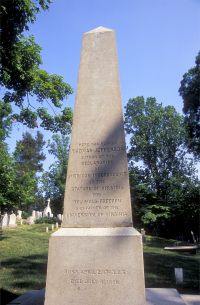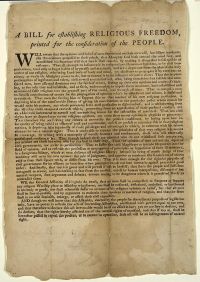Divided We Stand, United We Fall
Why the Virginia Statute for Establishing Religious Freedom is the key to political freedom and free thought.
‘divided we stand, united we fall’
—Thomas Jefferson to Jacob de La Motta, 1 September 1820
 Thomas Jefferson asked that three things, and only three things, be remembered on any grave marker honoring him: He was the author of the Declaration of Independence and the Virginia Statute for Establishing Religious Freedom, and father of the University of Virginia.
Thomas Jefferson asked that three things, and only three things, be remembered on any grave marker honoring him: He was the author of the Declaration of Independence and the Virginia Statute for Establishing Religious Freedom, and father of the University of Virginia.
Undoubtedly, the meticulous Jefferson thought about this list more than in passing; it was not a whim. For Jefferson, these three things were his life’s work. To him, they were so important that his public service as president, secretary of state and ambassador didn’t make the cut, and they were so much a part of his character that these things overshadowed his roles as devoted father, husband and son.
Help ensure Jefferson's legacy of freedom.
These three things — political liberty, religious liberty and education — were the essential building blocks of the society that Jefferson and other founders fought to form: a real republic.
Make no mistake though: For Jefferson, the foundation was religious freedom, without which citizens would not be able to think for themselves, to question, to learn or to govern. It was in this context that Jefferson said, “I have sworn upon the altar of god eternal hostility against every form of tyranny over the mind of man.”
Jefferson saw this issue clearly. No progress could be made in politics or education if “kings, priests and nobles” continued to use government power to propagate religion, seeking to control citizens’ minds. This is why religious freedom required a strict separation of church and state. Jefferson explained in 1808 that even an official proclamation of a day of national prayer violated the Constitution.
 The Virginia Statute proved essential to the development of American religious freedom. In 1879, the first Supreme Court case addressing the First Amendment’s religion clauses unanimously declared that the statute "defined" religious freedom, including the "true distinction between what properly belongs to the church and what to the State." Since then, the Court has repeatedly turned to the statute.
The Virginia Statute proved essential to the development of American religious freedom. In 1879, the first Supreme Court case addressing the First Amendment’s religion clauses unanimously declared that the statute "defined" religious freedom, including the "true distinction between what properly belongs to the church and what to the State." Since then, the Court has repeatedly turned to the statute.
Jefferson’s goal was not his alone. While he and James Madison stood at the center of the fight for religious freedom, those two disciples of the Enlightenment could not have hoped to win the political battle had they not been joined by devout evangelical Presbyterians and Baptists. These deeply religious groups were adamant, for theological and political reasons, that mixing church and state corrupted both. Building on their support, Jefferson realized that American diversity itself underpinned religious freedom. Thus, Jefferson assured a Jewish correspondent that in the case of religious freedom, “divided we stand, united we fall,” explaining that “religious freedom is the most effectual Anodyne against religious dissension” (not unlike Madison’s conclusion in Federalist No. 10 that a broad diversity of political views would make a tyranny of the majority more difficult).
These Jeffersonian ideals spread far beyond America. When serving as ambassador to France, Jefferson heard about the statute’s adoption in 1786 and had it translated into French and Italian (his original version, of course, rather than the slightly edited version actually adopted). In Hungary, the law was translated into Latin and introduced in the Hungarian legislature in its entirety. In England, one newspaper reprinted the statute with Jefferson’s eulogy, noting, “It may be considered as the religious charter of a free, happy, and thriving country.” Jeffersonian religious freedom became an emblem of America, with the statute reprinted in brochures encouraging emigration. In the intervening 231 years, those seeking freedom around the world have regularly turned to its provisions.
On no issue was Jefferson’s vision more prescient. He was emphatic that American religious freedom was “meant to comprehend, within the mantle of its protection, the Jew and the Gentile, the Christian and Mahometan, the Hindoo, and Infidel of every denomination.” He was equally clear that while religious belief was fully protected, that could not justice illegal actions in the name of religion, be they acts of terrorism or acts of bigotry in violation of the law.
Andrew O’Shaughnessy, the Saunders Director of the Robert H. Smith International Center for Jefferson Studies at Monticello, reminds us that in the Declaration of Independence, Jefferson penned “America’s mission statement.” In the statute, I suggest, he also inscribed “America’s creed.”
Eighteenth-century opponents of Jeffersonian freedom and their 21st-century kin insist that separation of church and state will destroy religion. History proves them wrong. In Germany, taxes still support the church; in Italy, every public classroom has a crucifix; in England, the “official” church prays for the monarch.
Yet the pews are mostly empty on Sunday. America’s separation of church and state has created a vibrant “free market” for religion. Or, as Jefferson said: “We have solved, by fair experiment, the great & interesting question Whether freedom of religion is compatible with order in government, and obedience to the laws. & we have experienced the quiet as well as the comfort which results from leaving every one to profess freely & openly those principles of religion which are the inductions of his own reason, & the serious convictions of his own enquiries.”


